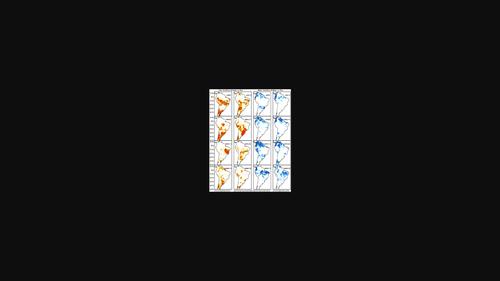当前位置:
X-MOL 学术
›
Int. J. Climatol.
›
论文详情
Our official English website, www.x-mol.net, welcomes your feedback! (Note: you will need to create a separate account there.)
Multiyear La Niña effects on the precipitation in South America
International Journal of Climatology ( IF 3.9 ) Pub Date : 2022-08-29 , DOI: 10.1002/joc.7847 Aixa Braga Lopes 1 , Rita V. Andreoli 2 , Rodrigo A.F. Souza 2 , Wilmar L. Cerón 1, 3 , Mary T. Kayano 4 , Teresita Canchala 5 , Djanir Sales de Moraes 1
International Journal of Climatology ( IF 3.9 ) Pub Date : 2022-08-29 , DOI: 10.1002/joc.7847 Aixa Braga Lopes 1 , Rita V. Andreoli 2 , Rodrigo A.F. Souza 2 , Wilmar L. Cerón 1, 3 , Mary T. Kayano 4 , Teresita Canchala 5 , Djanir Sales de Moraes 1
Affiliation

|
The effect of multiyear La Niña (LN) events on precipitation in South America (SA) was assessed considering 10 persistent LN events over two successive years, referred to as Y1 and Y2 for the 1901–2012 period. Y1 spans from the austral winter of the first year to autumn of the second year, and Y2 spans from the austral winter of the second year to autumn of the third year. Comparisons were performed season by season of the Y1 and Y2. Composites revealed that the teleconnections related to a multiyear LN event during its Y1 and Y2 years, responsible for distinct seasonal precipitation anomaly patterns in SA, were associated with different tropical ocean conditions. In spring, the negative sea surface temperature (SST) dipole in the Indian Ocean during the Y2 was not observed during Y1. Different LN-related SST anomaly patterns in the tropical Atlantic between Y1 and Y2 occurred in the other seasons. Over northern/northeastern SA, the positive precipitation anomalies became weaker (stronger) during austral summer and autumn (winter and spring) of the Y2 than Y1 and were associated with changes in the Walker cells. During austral spring and summer, southeastern presented drier conditions during the Y2 than Y1. In the spring of Y2, two Rossby wave trains, one associated with the LN-related anomalous cooling in the equatorial Pacific and another triggered by the upper-level anticyclone in the tropical Indian Ocean, characterized the circulation pattern over SA which explains the difference in precipitation anomalies between the Y2 and Y1. These drier (wetter) conditions during austral spring and summer (winter and spring), particularly over southern and southeastern Brazil (Colombia) in the Y2, might have more severe effects on the regional hydrological cycle than those in the Y1. The results here indicate that accurate prediction of LN duration is crucial in a climate-monitoring context.
中文翻译:

多年拉尼娜对南美洲降水的影响
多年拉尼娜 (LN) 事件对南美洲 (SA) 降水的影响评估了连续两年的 10 次持续性 LN 事件,在 1901-2012 年期间称为 Y1 和 Y2。Y1 为第一年南冬至第二年秋,Y2 为第二年南冬至第三年秋。逐季对 Y1 和 Y2 进行比较。复合材料显示,与 Y1 和 Y2 年期间的多年 LN 事件相关的遥相关,导致 SA 中不同的季节性降水异常模式,与不同的热带海洋条件有关。在春季,Y2 期间印度洋的负海面温度 (SST) 偶极子在 Y1 期间未观察到。Y1和Y2之间热带大西洋不同的LN相关SST异常模式出现在其他季节。在南极洲北部/东北部,Y2 南半球夏季和秋季(冬季和春季)的正降水距平比 Y1 弱(强),并且与 Walker 细胞的变化有关。南半球春夏季节,Y2 东南部比Y1 干燥。在 Y2 的春天,两个罗斯贝波列,一个与赤道太平洋与 LN 相关的异常冷却有关,另一个由热带印度洋的上层反气旋触发,表征了 SA 上的环流模式,这解释了Y2和Y1之间降水异常。在南方春季和夏季(冬季和春季)期间,这些更干燥(更潮湿)的条件,特别是在 Y2 的巴西南部和东南部(哥伦比亚),可能比 Y1 对区域水文循环产生更严重的影响。这里的结果表明,准确预测 LN 持续时间在气候监测环境中至关重要。
更新日期:2022-08-29
中文翻译:

多年拉尼娜对南美洲降水的影响
多年拉尼娜 (LN) 事件对南美洲 (SA) 降水的影响评估了连续两年的 10 次持续性 LN 事件,在 1901-2012 年期间称为 Y1 和 Y2。Y1 为第一年南冬至第二年秋,Y2 为第二年南冬至第三年秋。逐季对 Y1 和 Y2 进行比较。复合材料显示,与 Y1 和 Y2 年期间的多年 LN 事件相关的遥相关,导致 SA 中不同的季节性降水异常模式,与不同的热带海洋条件有关。在春季,Y2 期间印度洋的负海面温度 (SST) 偶极子在 Y1 期间未观察到。Y1和Y2之间热带大西洋不同的LN相关SST异常模式出现在其他季节。在南极洲北部/东北部,Y2 南半球夏季和秋季(冬季和春季)的正降水距平比 Y1 弱(强),并且与 Walker 细胞的变化有关。南半球春夏季节,Y2 东南部比Y1 干燥。在 Y2 的春天,两个罗斯贝波列,一个与赤道太平洋与 LN 相关的异常冷却有关,另一个由热带印度洋的上层反气旋触发,表征了 SA 上的环流模式,这解释了Y2和Y1之间降水异常。在南方春季和夏季(冬季和春季)期间,这些更干燥(更潮湿)的条件,特别是在 Y2 的巴西南部和东南部(哥伦比亚),可能比 Y1 对区域水文循环产生更严重的影响。这里的结果表明,准确预测 LN 持续时间在气候监测环境中至关重要。


























 京公网安备 11010802027423号
京公网安备 11010802027423号